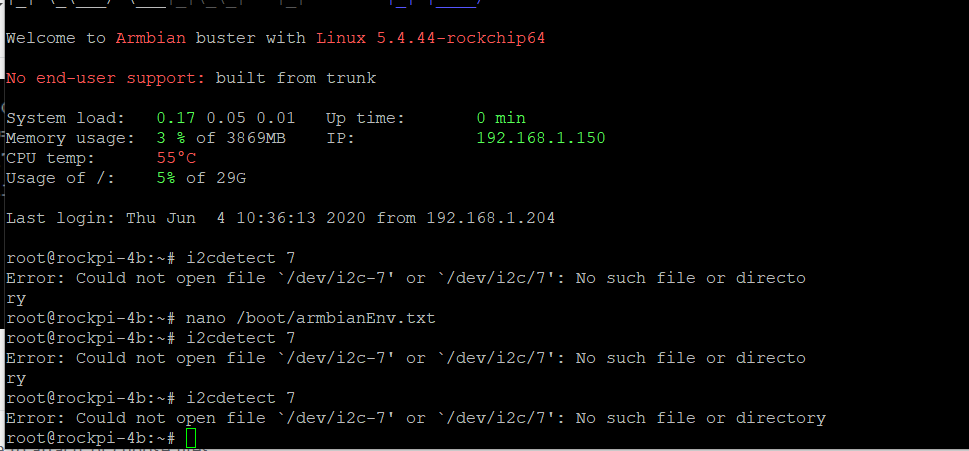Search the Community
Showing results for tags 'rockpi-4b'.
-
People, help install the system on eMMC Rock Pi 4 Bv 1.3. Installed the system "Arabian_20. 05.4_Rocky-4b_focal_current_5. 4. 46_desktop" on SD, installed eMMC on the Board, started the system and updated it. Then I tried two options for transferring the system to emc: 1) (https://docs.armbian.com/User-Guide_Getting-Started/) sudo nano-sata-install - dd if= / dev/zero of= / dev/mmcblk2 bs=1024 seek=8 count=1; 2) armbian-config - boot from SD, system on SATA / USB. But both options failed. I read here two branches with a discussion of this problem, but I did not succeed. But this is because I am not a very experienced Linux user. Please give me a normal recipe!
-
Hey folks, So here's the setup I have: I have an Orange Pi 4B running the Orange Pi 4 image and kernel 5.6.17-rockchip64. I have an Orange Pi 4 running the Orange Pi RK3399 image and kernel 5.4.26-rockchip64 (cause when I got it, the Orange Pi 4 images weren't out yet). The OPi4 is running just fine. I imagine that I'm running the wrong DTB and that not all the hardware is working properly -- but the hardware I need is working just fine. The OPi4B is another story. It'll boot just fine, and it'll run just fine for days/weeks on end -- as long as I don't put it under any sort of heavy CPU load. But if I start running anything CPU-intensive (such as compiling software), it'll run for a few minutes before rebooting. I suspect that the CPU is overheating and the thermal protection code is tripping -- cause if I run htop while the compile job is going, I can see the CPU temperature rise until it hits 94°C, after which it reboots. It kinda looks like not all of the cores are throttling down -- at the point that it rebooted, the big cores were running at 408MHz, but the LITTLE cores were still running at 1.51GHz. I'm not sure what to do here. I've done a side-by-side comparison of the DTS's for the two, and I can't see any meaningful differences between the two -- but then again, I'm not familiar with DTS's enough to really know what I'm looking at. I've also tried several different kernel versions with no luck. Can anyone give me any pointers?
-
As topics title, did anyone manage to get the Raspberry Pi Touch Screen (DSI) work with the Rock Pi 4B running Armbian? Should it be working out of the box like with the TinkerBoard? Note that in my setup the display works with the Radxa Debian 9 image. Thanks guys
-
This overlays settings worked well until I have compiled my own .dtbo file and call it with overlay=..xyz... , after that all yet working overlays stopped working, even if I removed them. The boot process now skips this overlay settings. After examination, I have found file "/boot/boot.scr" and "/boot/dtb-5.4.44-rockchip64/rockchip/overlay/rockchip-fixup.scr" had some garbage characters at beginning. I didn't change anything, neither I did open them before, those files simply got garbage. After deleting the garbage chars, it won't boot anymore. Before I had tried also spi-spidev and spi-nor
-
Hi, I don't have an idea why it stucks. Armbian_20.05.0-trunk_Rockpi-4b_buster_current_5.4.43 EDIT: I have downloaded the pre-build image Armbian_20.05.1_Rockpi-4b_buster_current_5.4.43 and it works. It boots at an astonishing speed, only 18 sec which is a miracle. How can I build the same kernel? Is sufficient to copy just a .config file? T T DDR Version 1.13 20180801 In Channel 0: LPDDR4,50MHz CS = 0 MR0=0x98 MR4=0x3 MR5=0xFF MR8=0x8 MR12=0x4D MR14=0x4D MR18=0x0 MR19=0x0 MR24=0x8 MR25=0x0 CS = 1 MR0=0x18 MR4=0x2 MR5=0xFF MR8=0x8 MR12=0x4D MR14=0x4D MR18=0x0 MR19=0x0 MR24=0x8 MR25=0x0 Bus Width=32 Col=10 Bank=8 Row=15/15 CS=2 Die Bus-Width=16 Size=2048MB Channel 1: LPDDR4,50MHz CS = 0 MR0=0x98 MR4=0x2 MR5=0xFF MR8=0x8 MR12=0x4D MR14=0x4D MR18=0x0 MR19=0x0 MR24=0x8 MR25=0x0 CS = 1 MR0=0x18 MR4=0x2 MR5=0xFF MR8=0x8 MR12=0x4D MR14=0x4D MR18=0x0 MR19=0x0 MR24=0x8 MR25=0x0 Bus Width=32 Col=10 Bank=8 Row=15/15 CS=2 Die Bus-Width=16 Size=2048MB 256B stride channel 0 CS = 0 MR0=0x98 MR4=0x3 MR5=0xFF MR8=0x8 MR12=0x72 MR14=0x72 MR18=0x0 MR19=0x0 MR24=0x8 MR25=0x0 CS = 1 MR0=0x18 MR4=0x2 MR5=0xFF MR8=0x8 MR12=0x72 MR14=0x72 MR18=0x0 MR19=0x0 MR24=0x8 MR25=0x0 channel 1 CS = 0 MR0=0x98 MR4=0x2 MR5=0xFF MR8=0x8 MR12=0x72 MR14=0x72 MR18=0x0 MR19=0x0 MR24=0x8 MR25=0x0 CS = 1 MR0=0x18 MR4=0x2 MR5=0xFF MR8=0x8 MR12=0x72 MR14=0x72 MR18=0x0 MR19=0x0 MR24=0x8 MR25=0x0 channel 0 training pass! channel 1 training pass! change freq to 400MHz 0,1 channel 0 CS = 0 MR0=0x98 MR4=0x82 MR5=0xFF MR8=0x8 MR12=0x72 MR14=0x72 MR18=0x0 MR19=0x0 MR24=0x8 MR25=0x0 CS = 1 MR0=0x18 MR4=0x2 MR5=0xFF MR8=0x8 MR12=0x72 MR14=0x72 MR18=0x0 MR19=0x0 MR24=0x8 MR25=0x0 channel 1 CS = 0 MR0=0x98 MR4=0x2 MR5=0xFF MR8=0x8 MR12=0x72 MR14=0x72 MR18=0x0 MR19=0x0 MR24=0x8 MR25=0x0 CS = 1 MR0=0x18 MR4=0x2 MR5=0xFF MR8=0x8 MR12=0x72 MR14=0x72 MR18=0x0 MR19=0x0 MR24=0x8 MR25=0x0 channel 0 training pass! channel 1 training pass! change freq to 800MHz 1,0 ch 0 ddrconfig = 0x101, ddrsize = 0x2020 ch 1 ddrconfig = 0x101, ddrsize = 0x2020 pmugrf_os_reg[2] = 0x3AA1FAA1, stride = 0xD OUT U-Boot SPL board init U-Boot SPL 2017.09-armbian (Jun 01 2020 - 06:46:11) Trying to boot from MMC2 Card did not respond to voltage select! mmc_init: -95, time 10 spl: mmc init failed with error: -95 Trying to boot from MMC1 NOTICE: BL31: v1.3(debug):65aa5ce NOTICE: BL31: Built : 10:47:37, Jun 19 2018 NOTICE: BL31: Rockchip release version: v1.1 INFO: GICv3 with legacy support detected. ARM GICV3 driver initialized in EL3 INFO: Using opteed sec cpu_context! INFO: boot cpu mask: 0 INFO: plat_rockchip_pmu_init(1151): pd status 3e INFO: BL31: Initializing runtime services WARNING: No OPTEE provided by BL2 boot loader, Booting device without OPTEE initialization. SMC`s destined for OPTEE will return SMC_UNK ERROR: Error initializing runtime service opteed_fast INFO: BL31: Preparing for EL3 exit to normal world INFO: Entry point address = 0x200000 INFO: SPSR = 0x3c9 U-Boot 2017.09-armbian (Jun 01 2020 - 06:46:11 +0000) Model: Radxa ROCK Pi 4 DRAM: 3.9 GiB DCDC_REG1@vdd_center: ; enabling DCDC_REG2@vdd_cpu_l: ; enabling DCDC_REG3@vcc_ddr: ; enabling (ret: -38) DCDC_REG4@vcc_1v8: set 1800000 uV; enabling LDO_REG1@vcc1v8_dvp: set 1800000 uV; enabling LDO_REG2@vcc3v0_touch: set 3000000 uV; enabling LDO_REG3@vcc1v8_pmu: set 1800000 uV; enabling LDO_REG4@vcc_sd: set 3300000 uV; enabling LDO_REG5@vcca3v0_codec: set 3000000 uV; enabling LDO_REG6@vcc_1v5: set 1500000 uV; enabling LDO_REG7@vcca1v8_codec: set 1800000 uV; enabling LDO_REG8@vcc_3v0: set 3000000 uV; enabling SWITCH_REG1@vcc3v3_s3: ; enabling (ret: -38) SWITCH_REG2@vcc3v3_s0: ; enabling (ret: -38) vcc1v8-s0@vcc1v8_s0: set 1800000 uV; enabling (ret: -38) dc-12v@dc_12v: set 12000000 uV; enabling (ret: -38) vcc-sys@vcc_sys: set 5000000 uV; enabling (ret: -38) vcc3v3-sys@vcc3v3_sys: set 3300000 uV; enabling (ret: -38) vcc-phy-regulator@vcc_phy: ; enabling (ret: -38) vdd-log@vdd_log: ; enabling (ret: -38) MMC: sdhci@fe330000: 0, dwmmc@fe320000: 1 SF: unrecognized JEDEC id bytes: ff, ff, ff *** Warning - spi_flash_probe_bus_cs() failed, using default environment In: serial@ff1a0000 Out: serial@ff1a0000 Err: serial@ff1a0000 Model: Radxa ROCK Pi 4 boot mode 0. Net: eth0: ethernet@fe300000 Hit any key to stop autoboot: 0 Card did not respond to voltage select! mmc_init: -95, time 10 switch to partitions #0, OK mmc0(part 0) is current device Scanning mmc 0:1... starting USB... USB0: USB EHCI 1.00 USB1: USB EHCI 1.00 USB2: Register 2000140 NbrPorts 2 Starting the controller USB XHCI 1.10 USB3: Register 2000140 NbrPorts 2 Starting the controller USB XHCI 1.10 scanning bus 0 for devices... 1 USB Device(s) found scanning bus 1 for devices... 1 USB Device(s) found scanning bus 2 for devices... 1 USB Device(s) found scanning bus 3 for devices... 1 USB Device(s) found scanning usb for storage devices... 0 Storage Device(s) found Device 0: unknown device ethernet@fe300000 Waiting for PHY auto negotiation to complete.... done Speed: 1000, full duplex BOOTP broadcast 1 BOOTP broadcast 2 DHCP client bound to address 192.168.1.134 (257 ms) *** Warning: no boot file name; using 'C0A80186.img' Using ethernet@fe300000 device TFTP from server 192.168.1.1; our IP address is 192.168.1.134 Filename 'C0A80186.img'. Load address: 0x800800 Loading: T T T T T T T T T T Retry count exceeded; starting again missing environment variable: pxeuuid missing environment variable: bootfile Retrieving file: pxelinux.cfg/01-36-bb-f1-14-ce-8a Speed: 1000, full duplex
-
Hello all, After some time without touching it, I came back to my Rockpi 4B. I installed the latest armbian bionic image on a samsung 64Go card. All seems to work fine for the first boot. But when I try to restart the system I don't get any display on screen. To get it back I need to unplug HDMI plug and re-plug it. Didn't found any conversation about that trouble? Is it a bug or is there something I can do to fix it ? Thanks for your answers. Pat
-
Hi, I have one silly problem developing a FBTFT device driver for SSD1322 display : https://github.com/MarkoBursic/fbtft---SSD1322/blob/master/fb_ssd1322.c The initialisation starts OK, all GPIOs (DC, RESET, CS) follows as they should, since the data is sent through a function write_reg. For example : write_reg(par, 0xA0, 0x14, 0x11); It asserts DC low, then sends 0xA0, then asserts DC high and sends 0x14 and 0x11. Within every sent character (8bit bata) the CS toggles. The problem becomes when I want to send video data, I guess a function write_vmem is called. But here the entire tx buffer is filled and then streamed. for (y = 0; y < bl_height; y++) { for (x = 0; x < bl_width / 2; x++) { *buf = cpu_to_le16(rgb565_to_y(vmem16[offset++])) >> 8 & 0xF0; *buf++ |= cpu_to_le16(rgb565_to_y(vmem16[offset++])) >> 12; } } /* Write data */ ret = par->fbtftops.write(par, par->txbuf.buf, bl_width/2*bl_height); In fact the whole buffer is sent from SPI but the CS doesn't toggle every 8-th clock pulse, it is just asserted low and then streamed out whole 8kB. Is there any settings on SPI to tell that it has to toggle, for example the dtb ovelay for FBTFT device has a setting: buswidth=<8>; but it seems that it doesn't take care of it. Any advice? p.s.: the code was cloned from other sites that have used this device on RPi. EDIT: Problem is solved. I had a test example from BuyDisplay.com written for RPi, which sent data with toggling CS for each sent byte. I have patched this example and found out that SSD1322 works even better with a continuous stream without toggling CS when sending VRAM buffer. Later, the problem on my Rockpi4 and linux FBTFT driver was found to be a RES signal, which is active low. Therefore the display was hold in reset every time due to wrong parameter setting in DT overlay.
-
I have 2 issues in LibreOffice installed by default in Armbian, running on RockPi 4B. First: special characters aren't working. Second: filenames or folders using special characters are not recognized - therefore I can't access or edit my files, and even can't save files with special characters... anyone has a tip to solve these two issues? Thanks a lot
-
I want to use the mainline u-boot spl to load the u-boot proper(u-boot.itb) from nvme, so that the only part off the nvme is the tpl/spl in the emmc/sd/spi flash. But now the mainline u-boot has no pcie driver and no nvme support in spl. I have found the radxa guys using their u-boot in spi flash to boot kernel from nvme. But their pcie driver(https://github.com/radxa/u-boot/commit/096f2c16bbfa24c93a4c87e31334d5b5064dfd0a) has a limitation: It can not be used in u-boot spl, or it would not function properly in u-boot proper and fail the boot. After some frustrating tryings and compare with the linux driver, I found that the port initialization process was short cutted and causing the reinitialization malfunctioned. After this correction the pcie driver can be used in spl: it can be reinitialized correctly in u-boot proper. Bring nvme support into spl is just a mimic from the spl_mmc and spl_usb driver. Another patch for fixing spl_ext as I want the u-boot.itb and kernel in a ext4 partition on nvme but the existing spl_ext can not load the u-boot.itb properly. With these patches I can boot nanopc-t4 with u-boot.itb and linux kernel in nvme boot partition and only the u-boot tpl/spl in emmc. Btw, now the vidconsole of the mainline u-boot is working on rk3399, but usb phys are still missing. pcie.patch rk3399_boot_nvme.patch spl_ext_fix.patch spl_nvme.patch
-
I had compiled the Armbian image: Buster server. It shows like: Linux version 5.4.35-rockchip64 (root@ubuntu-bionic) ??? uname -r 5.4.35-rockchip64 If I download the linux headers it downloads them, but version 5.4.32-rockchip64. If I do : apt-get source linux-source-$(uname -r) Reading package lists... Done E: You must put some 'source' URIs in your sources.list root@rockpi-4b:~# I can't compile the device drivers, since the headers are different.
-
Hello i made a mistake when i was selecting an other kernel via armbian-config. I was powering off the board after the kernel change (which normally worked fine when i switched between dev and current) and this time something wrong happened i dont know what exactly but the VMLinuz and uinitram is missing in boot. How can i chroot my Armbian system so re-run armbian-config and install the kernel properly? I tried several other things,,.. copying the boot folder from a working install of armbian but i dont really know which kernel he wants. The easiest thing might be chrooting... but i dont know how to chroot my emmc. I plugged it into the emmc adapter (microsd) and i now can access the filesystem with my linux notebook.
-
tried several Images Bionic, Buster Desktop and several Kernels 4.4 - 5.6... Can't get to work HDMI Output (black screen on 4.4) and Bluetooth (firmware issue missing file) on same kernel version. Did someone has a working build for Rock Pi 4 board v1.4? Thanks
-
Hi, I am doing some overlay for fbtft LCD driver - SSD1322. I did compile an add my patch, now I would like to load the LCD driver with DT overlay. This is what I have done: /dts-v1/; /plugin/; / { compatible = "rockchip,rk3399"; fragment@0 { target = <&spi1>; __overlay__ { status = "okay"; }; }; fragment@1 { target = <&spi1>; __overlay__ { /* needed to avoid dtc warning */ #address-cells = <1>; #size-cells = <0>; status = "okay"; mytft@0{ compatible = "solomon,ssd1322"; reg = <0>; spi-max-frequency = <1000000>; buswidth = <8>; rotate = <0>; bgr = <0>; fps = <20>; reset-gpios = <0>, <1 21 1 0xae>; dc-gpios = <0>, <1 21 1 0xae>; debug = <0>; status = "okay"; }; }; }; }; Now the problem is, that I haven't found any information on how those GPIOs are defined. I took pieces of code here and there, the gpio declaration comes from user @martinayotte cs-gpio = <0>, <1 21 1 0xae>; // csgpio = <&gpio1 21 1 0xae>; // csgpio = <&pinctrl/gpio1@ff730000 21 1 0xae>; He uses several ways to declare them, but what really means <0>, <1 21 1 0xae> ? How can I compute this kind of coding for arbitrary RK3399 Gpio? 0001-Signed-off-by-root-marko.bursic73-gmail.com.patch EDIT: I have found this https://forum.radxa.com/t/how-to-control-the-gpio/148/32 So my assumption is to control GPIO4_D5 it should be dc-gpios = <&gpio4 29 1 0xae>; Since D=3, then 3*8+5=29. Still don't know what 1 and 0xae means, but obviously is wrong. The dmesg reveals invalid GPIO . Call trace: [ 81.742210] gpio_to_desc+0xa8/0xf0 [ 81.742222] write_vmem+0x38/0x190 [ 81.742232] fbtft_update_display+0xd0/0x218 [ 81.742241] fbtft_deferred_io+0xc0/0xd8 [ 81.742250] fb_deferred_io_work+0xdc/0x158 [ 81.742261] process_one_work+0x1e0/0x338 [ 81.742270] worker_thread+0x40/0x440 [ 81.742282] kthread+0x120/0x128 [ 81.742294] ret_from_fork+0x10/0x18 [ 81.742301] ---[ end trace 8a7abacfafe1f15a ]--- [ 81.945879] ------------[ cut here ]------------ [ 81.945890] invalid GPIO -257459296 [ 81.945950] WARNING: CPU: 4 PID: 507 at drivers/gpio/gpiolib.c:126 gpio_to_desc+0xa8/0xf0
-
Hello, i want to use a NRF24L01 on my Rock PI 4B. I found out that i cannot enable spidev0.0 because this is corresponding with the network interface. Linux rockpi 5.4.32-rockchip64 #20.02.11 SMP PREEMPT Tue Apr 14 17:30:19 CEST 2020 aarch64 GNU/Linux Linux version 5.4.32-rockchip64 (root@builder) (gcc version 8.3.0 (GNU Toolchain for the A-profile Architecture 8.3-2019.03 (arm-rel-8.36))) #20.02.11 SMP PREEMPT Tue Apr 14 17:30:19 CEST 2020 My armbianENV looks like this: verbosity=1 overlay_prefix=rockchip overlays=spi-add-cs1 spi-spidev param_spidev_spi_bus=1 rootdev=UUID=3c50a1d1-71a5-4a0f-9899-099b17a1050b rootfstype=ext4 usbstoragequirks=0x2537:0x1066:u,0x2537:0x1068:u When i set param_spidev_spi_bus=0 then the board boots up without eth0 (no ethernet) when i use bus=1 then it works. My Problem is i want to use Mysensors, i get no errors but my NRF does not receive any signal. Has someone ever done this before?
-
Hi! Unless mistaken, I believe audio is missing from 3.5mm jack on the RockPi4b. To enable it, I had: - To update the dts by adding definitions close to the RockPro64 (some available starting in mainline 5.6) - Change them to use I2S0 instead of I2S1 - Enable audio-graph-card in kernel config (I also removed some audio modules which issued warnings/errors during boot) - Patch es8316.c to prevent a kernel panic during boot (found in Ayufan's latest mainline kernel for RockPro64) yannick@rockpi-4b:~$ aplay -l **** List of PLAYBACK Hardware Devices **** card 0: rockchiprk3399 [rockchip,rk3399], device 0: ff880000.i2s-ES8316 HiFi ES8316 HiFi-0 [ff880000.i2s-ES8316 HiFi ES8316 HiFi-0] Subdevices: 1/1 Subdevice #0: subdevice #0 card 1: hdmisound [hdmi-sound], device 0: ff8a0000.i2s-i2s-hifi i2s-hifi-0 [ff8a0000.i2s-i2s-hifi i2s-hifi-0] Subdevices: 1/1 Subdevice #0: subdevice #0 And finally, activate the proper DACs with amixer: amixer set 'Right Headphone Mixer Right DAC' on amixer set 'Left Headphone Mixer Left DAC' on Would you like a PR for this? Cheers, and thanks for your work on Armbian!
-
Good morning gentlemen, I have just discovered that one of the cores on my RockPi4B is faulty and often causes segfaults and crashes, I can disable the suspect core by issuing the following command $ sudo echo 0 | sudo tee /sys/devices/system/cpu/cpu2/online However, this is fine if the machine has booted, but i want to disable the faulty core as early on in the boot process as possible. Is it possible to disable the core in the uboot environment, or could someone offer me some advice as to the best time to disable the core? Thanks, Leon.
-
Hello, I think this is my first post here. I am trying to operate an Epson L4150 on-board Rock pi4 b multifunction printer. I was successful in running the printer. But the scanner is another story. Xsane does not recognize it. I have been trying to install the driver which is downloaded from the Epson page, but it is for armhf. I tried a dpkg --add-architecture armhf, then update, but when I try to run install.sh from the Epson driver, it throws error: E: Failed to locate package libboost-filesystem1.58.0 Somebody could help me? Thank you
-
I have Rock Pi4B and printer 3D Sapphire Pro from Two Trees. In the Armbian I want use print server OctoPrint. Instalation OctoPrint was easly and server works but don't connect to my printer. When I use lsusb i see Bus 004 Device 003: ID 1a86:7523 QinHeng Electronics HL-340 USB-Serial adapter. In the list dev/tty* don't shows me mounting port to this device. I try defined udev rules: SUBSYSTEM=="tty", ATTRS{idVendor}=="1a86", ATTRS{idProduct}=="7523", SYMLINK+="sapphire" or SUBSYSTEM=="tty", ATTRS{idVendor}=="1a86", ATTRS{idProduct}=="7523", ATTRS{devpath}=="1.2", SYMLINK+="sapphire" but without fine result. I'm rookie in linux and armbian and don't have the idea whot do it to valid define. Please help me.
-
Hi All, thanks for this great project, much appreciated! Could someone give me an educated guess whether there is a risk of damaging my board when the blue LED is flashing much faster (at least twice, probably more) than usual? I suspect something is changing the frequency or voltage and I'm not sure how much time I can take in this state to try to analyze the problem further. For now I unplug the power when it happens. I'm trying to netboot my Rock Pi 4B v1.4 with the current or dev branches of buster minimal nfsboot, with no local storage at all (just the SPI flash for u-boot). The legacy 4.4 hangs at very early boot (couldn't get clock / Failed to get pclk) so I gave up on that, but it does work fine when running from an SD card. With the vanilla rootfs.tgz for 5.4.y/5.5.y extracted on the NFS server the boot process waits for 90 seconds trying to mount a device by UUID on /boot. Then I get the maintenance prompt where I can login with the default root password and all is relatively fine and working. I commented out the offending line in /etc/fstab. Now when I reboot, the board seems to hang somewhere in the boot process (I see the mount of root on the NFS server logs, the last messages on the monitor are "Started Serial Getty on ttyS2." and "Started Getty on tty1."; the last messages on the serial console are "[ 55.471075] systemd[1]: Reached target Swap." and "[ 55.471789] random: systemd: uninitialized urandom read (16 bytes read)") and then the frequency of the blue LED slowly (over the course of 10-15 seconds or so?) increases to at least twice as fast. Any ideas what causes this and what it means? Thanks, Arjan
-
Hi I’m running now armbian 19.11.7 buster with kernel 5.4.8, and using a using a HP EX900 250GB NVMe. I used to have transfer nvme speeds around 400-500 MBps with radxa stretch linux 4.4 (and 700ish on pcie gen 2) In armbian it seems that the transfer rate is around half: raleonardo@rockpi:~$ sudo hdparm -t --direct /dev/nvme0n1 /dev/nvme0n1: HDIO_DRIVE_CMD(identify) failed: Inappropriate ioctl for device Timing O_DIRECT disk reads: 590 MB in 3.01 seconds = 196.11 MB/sec with overlays=pcie-gen2: raleonardo@rockpi:~$ sudo hdparm -t --direct /dev/nvme0n1 /dev/nvme0n1: HDIO_DRIVE_CMD(identify) failed: Inappropriate ioctl for device Timing O_DIRECT disk reads: 1140 MB in 3.00 seconds = 379.61 MB/sec I wonder if anybody else has similar issues, and if this anyway related with different kernel drivers in 5.x vs 4.4 ?
-
After bootup I get # systemd-analyze Bootup is not yet finished. Please try again later. # systemctl list-jobs JOB UNIT TYPE STATE 142 systemd-update-utmp-runlevel.service start waiting 114 rk3399-bluetooth.service start running 1 multi-user.target start waiting If I stop rk3399-bluetooth.service everything completes and list-jobs is clean, but then bluetooth stops working. I've tried a few things in the rk3399-bluetooth unit file but so far I've not been able to find a way to make systemd happy and finish cleanly. By the way, in the service file it uses "--use_baudrate_for_downloade", typo and should be "--use_baudrate_for_download"
-
I connect the rockpi 4 to a Samsung display whose normal resolution is 1680x1050 via a hdmi to dvi line, but the maxium resolution I can choose is 1280x1024. And when I connect it to a 4K tv via hdmi, the maxium resolution is 1920x1080, not 3840x2160. The legacy kernel (4.4.210) works perfectly in both cases.
-
When is it likely to get support and Armbian image for Orangi Pi 4B? Thanks Rajesh
-
Hello, I have read some threats with the same issue, armbian images are not booting, there is not HDMI signal when turn on rockpi4. General solution is trying armbian image stored on radxa server https://dl.radxa.com/rockpi/images/third-party/Armbian_5.67_Rockpi4b_Debian_stretch_default_4.4.154_desktop_20181210-gpt.img.gz this armbian version works fine but it's too old, also i'm interested to use latest armbian-ubuntu-bionic My case: I have a new rockpi4b 1.4v, not eMMC module, I have flashed several armbian versions on sdCard : https://dl.armbian.com/rockpi-4b/Bionic_legacy_desktop https://dl.armbian.com/rockpi-4b/Buster_legacy https://dl.armbian.com/rockpi-4b/Buster_current_desktop https://dl.armbian.com/rockpi-4b/Bionic_current_minimal .. and old versions archived None of them works! the issue is the same, not HDMI signal. I can boot fine using radxa images (armbian stretch and others OS stored there). Is possible something wrong on latest rockpi4 hardware and need a fix on armbian/uBoot configuration?









